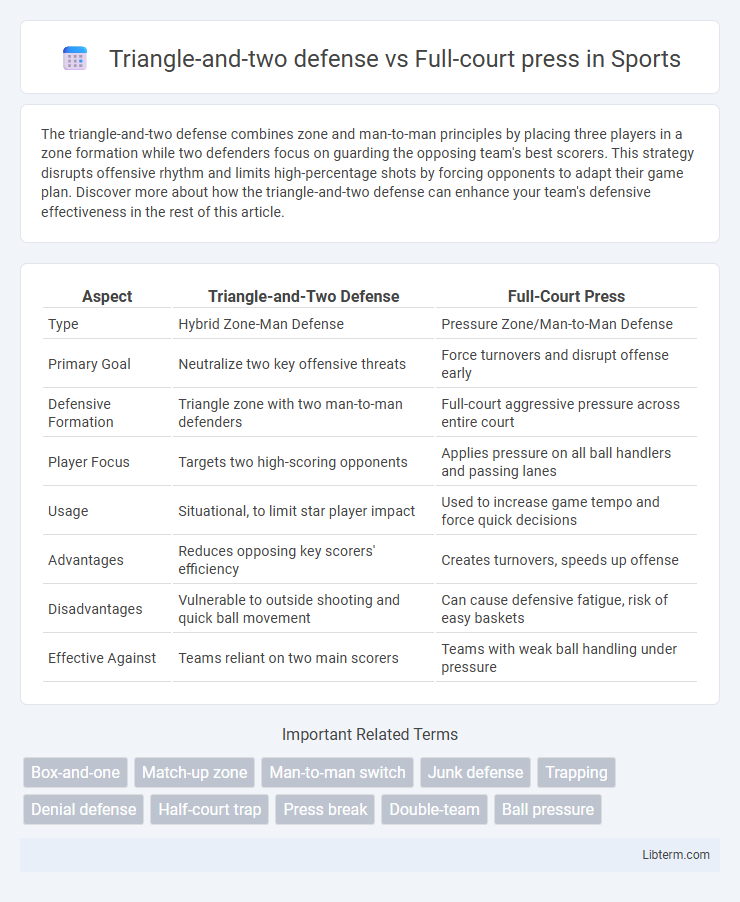The triangle-and-two defense combines zone and man-to-man principles by placing three players in a zone formation while two defenders focus on guarding the opposing team's best scorers. This strategy disrupts offensive rhythm and limits high-percentage shots by forcing opponents to adapt their game plan. Discover more about how the triangle-and-two defense can enhance your team's defensive effectiveness in the rest of this article.
Table of Comparison
| Aspect | Triangle-and-Two Defense | Full-Court Press |
|---|---|---|
| Type | Hybrid Zone-Man Defense | Pressure Zone/Man-to-Man Defense |
| Primary Goal | Neutralize two key offensive threats | Force turnovers and disrupt offense early |
| Defensive Formation | Triangle zone with two man-to-man defenders | Full-court aggressive pressure across entire court |
| Player Focus | Targets two high-scoring opponents | Applies pressure on all ball handlers and passing lanes |
| Usage | Situational, to limit star player impact | Used to increase game tempo and force quick decisions |
| Advantages | Reduces opposing key scorers' efficiency | Creates turnovers, speeds up offense |
| Disadvantages | Vulnerable to outside shooting and quick ball movement | Can cause defensive fatigue, risk of easy baskets |
| Effective Against | Teams reliant on two main scorers | Teams with weak ball handling under pressure |
Understanding the Triangle-and-Two Defense
The Triangle-and-Two defense is a strategic basketball defense that combines zone and man-to-man principles, with three players forming a triangle zone while two defenders apply tight, man-to-man pressure on the opponent's best perimeter scorers. This defense effectively disrupts teams reliant on strong outside shooting and playmaking by limiting their primary ball handlers' effectiveness and forcing secondary players to create scoring opportunities. Against a full-court press, the Triangle-and-Two can adapt by providing structured passing lanes through the triangle while maintaining aggressive traps on key offensive threats in the press, balancing containment and pressure.
Overview of the Full-Court Press
The full-court press is an aggressive defensive strategy used to apply pressure on the ball handler throughout the entire court, aiming to force turnovers and disrupt the opposing team's offensive rhythm. It requires quick, coordinated movements and strong communication among defenders to trap opponents and intercept passes effectively. This defense contrasts with the Triangle-and-Two by focusing on team-wide pressure rather than isolating key offensive players.
Key Principles of Each Defensive Strategy
The Triangle-and-Two defense employs three players in a zone triangle formation combined with two defenders assigned to tightly guard the opposing team's best perimeter scorers, optimizing matchup efficiency and perimeter control. The Full-court press applies constant pressure across the entire court to disrupt the offense's inbound and ball-handling abilities, forcing turnovers and accelerating game tempo. Key principles of the Triangle-and-Two focus on zone coverage and selective man-to-man pressure, while the Full-court press emphasizes relentless ball pressure and strategic trapping.
Tactical Advantages of the Triangle-and-Two
The Triangle-and-Two defense offers tactical advantages against full-court presses by combining man-to-man coverage on key perimeter players with a zone framework that maintains defensive shape and limits passing lanes. This hybrid defense effectively disrupts the press's primary ball handlers while providing help defense in the paint, reducing fast-break opportunities. Its adaptability enables teams to contain aggressive presses and force turnovers through pressure on the ball without exposing vulnerabilities in interior defense.
Strengths of the Full-Court Press
The full-court press applies intense defensive pressure across the entire court, disrupting the offense's ability to initiate plays and forcing turnovers. Its strengths include speeding up the game tempo and creating scoring opportunities through steals and fast breaks. This aggressive defense challenges ball handlers, limits passing options, and exhausts opponents physically and mentally.
Situational Effectiveness: When to Use Each Defense
The Triangle-and-Two defense excels against teams with one or two dominant scorers by combining zone coverage with focused man-to-man pressure to limit key players' impact. Full-court press is most effective in high-pressure scenarios, particularly when forcing turnovers or disrupting offensive rhythm early in the possession. Coaches opt for Triangle-and-Two in half-court settings to neutralize star threats, while full-court press suits fast-paced games or late-game situations requiring aggressive ball control.
Player Roles and Responsibilities
In the Triangle-and-Two defense, two players primarily focus on tightly guarding the opposing team's best perimeter scorers, while the remaining three form a triangle zone to protect the paint and contest inside passes. This hybrid defense requires perimeter defenders to apply constant pressure on ball handlers, limiting dribble penetration and shot opportunities. Conversely, against a Full-court press, all five players share responsibilities in trapping ball handlers across the entire court, maintaining quick rotations, and ensuring outlets are covered to break the press efficiently.
Common Offensive Counters
Common offensive counters to the Triangle-and-two defense against a Full-court press include quick ball movement and strategic spacing to exploit gaps in the press. Utilizing sharp passing lanes and off-ball screens helps break the press's pressure points, allowing for easier advancement up the court. Players often initiate controlled dribble penetration and backdoor cuts to create scoring opportunities while neutralizing the combined man-to-man and zone pressure.
Impact on Game Tempo and Momentum
The Triangle-and-two defense slows game tempo by forcing the offense into half-court sets, limiting fast-break opportunities and controlling possession length. In contrast, the Full-court press accelerates game pace by applying continuous pressure, often creating turnovers and quick scoring chances. Momentum shifts rapidly during Full-court press due to increased defensive intensity, while the Triangle-and-two maintains steady control, focusing on disrupting key offensive players.
Choosing the Right Defense for Your Team
Selecting between the Triangle-and-Two defense and a Full-court press depends on your team's strengths and game situation. The Triangle-and-Two is effective against teams with two dominant scorers, combining a zone triangle formation with man-to-man coverage on key opponents to limit their impact. The Full-court press applies intense, continuous pressure to force turnovers and disrupt the opposing offense but requires high stamina and quick defensive rotations, making it ideal for teams with strong, conditioned defenders.
Triangle-and-two defense Infographic

 libterm.com
libterm.com